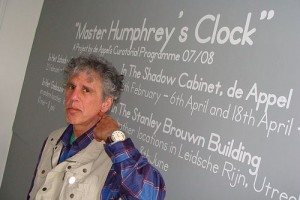
All About Time: Lucy Lippard and Seth Siegelaub at SITE Santa Fe
Seth Siegelaub’s disembodied voice echoes through the futuristically decorated, cement-floored chamber of the Time Capsule Lounge, part of SITE ‘s March 2012 Time-Lapse exhibition. The location is fitting: we are witnessing a conversation between Siegelaub and Lucy Lippard, two of the most influential people in the formation of and conversation about conceptual art in the 60s. The topic is Siegelaub’s revolutionary and radical exhibition March 1969, which was immortalized as One Month in Lucy Lippard’s book Six Years: the Dematerialization of the Art Object, an annotated bibliography documenting conceptual art from 1966 to 1972.

Seth Siegelaub
Further adding to the element of time and history, Siegelaub has been Skyped in for the dialog. Only, instead of the usual real-time display from his end of the virtual convo, Siegelaub sent in a still photograph of himself, wearing a Hawaiian shirt and standing on the rooftop of his home in Amsterdam. His voice reverberated around the space like a ghost from the past. Indeed, as the location suggested, the feeling in the room was akin opening a time capsule buried in the archives of art history and witnessing first hand an account of what, according to Lippard, was one of the most “wildly exciting” times in the history of art.

Lucy Lippard
One Month was the inspirational basis for SITE curators Irene Hofmann and Janet Dees’s formation of the March 2012 aspect of the Time-Lapse exhibition. As Dees said, “We wanted to give credit where credit was due, and to make sure people understood that March 2012 is part of a continuum,” that the concept was not “pulled out of the air.” A group exhibition consisting of artists invited by Siegelaub to send in work on a given day in March of 1969, One Month was the first exhibition produced entirely in catalog form, and fell in line with Lippard and Siegelaub’s intention to support work that could exist outside of the institution of the gallery/museum. The list consisted of such artists as Carl Andre, Mike Asher, Bruce Nauman and Sol Le Witt. The entire catalog is now available online in PDF form in Siegelaub’s online archive.
Hofmann and Dees perfectly adapted the highly conceptual idea (in the invitation to the artists, Siegelaub puts “work” in quotation marks) for today’s increasingly technology and web-based art world. Instead of publishing the work in a freely distributed catalog, 31 artists were selected to send in work on one day in March of 2012 to be published on a webpage, linked to SITE’s homepage. The project archive will be physically viewable at SITE for the months of April and May.
Throughout their dialog, Lippard and Siegelaub frequently referenced the financial context of the art world in 1969 when, as Lippard noted, “it was so much cheaper to send an artist than an artwork,” or, even better, to simply send a catalog. One of the most exciting moments of the dialog was when Siegelaub point-blank asked Dees if the exhibition had been cost-effective, given its predominantly “object-less” nature. Dees honestly fielded the question, noting that what it mostly cost, was time.
The question punctuated the irony of having a discussion sponsored by the art institution in 2012, that was very much about artists in the 1960s gaining freedom from and exercising authority over museums and galleries—through things like the Art Workers Coalition and the Artist’s Contract, drafted by Siegelaub himself. The fact appeared not to be lost on the audience, who, based on a show of hands prompted by Siegelaub, consisted mostly of artists and “friends of artists.”
In talking to audience members after the lecture, I heard a common note of grousing over the scale of Siegelaub’s photograph. It was projected larger than life on the wall next to Lippard, who sat on a stage up front. As a result, whenever Siegelaub spoke, no one quite knew where to look, including Lippard. Additionally, the delay produced by Siegelaub’s presence through Skype, caused both him and Lippard to frequently interrupt each other, giving way to long pauses in time during which Lippard grappled to find some rhythm of communication, thus compromising the sense of “real time” that the Skype usage was meant to facilitate. The destabilization this created in the audience and the participants brought the event outside of the mundane world of the museum lecture, and threw it headfirst into the reality-altering world of time-based performance art. In the end, the audience, and perhaps even SITE itself, was implicated in a Seth Siegelaub and Lucy Lippard happening, participants in one of SITE’s most elusive and conceptual art installations thus far.
